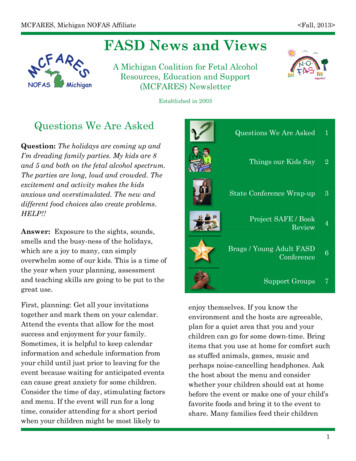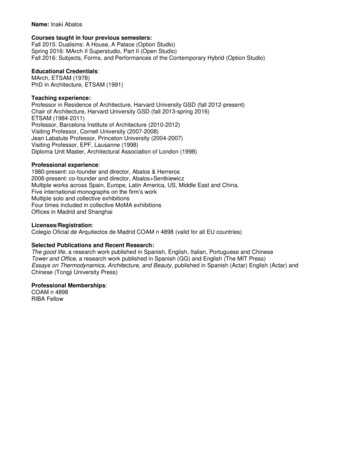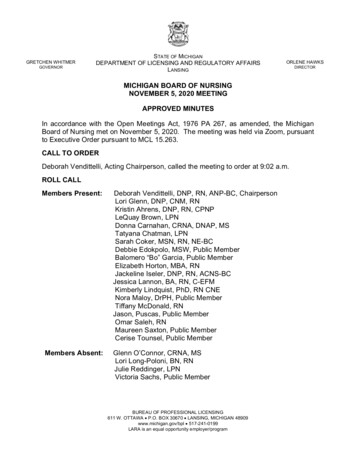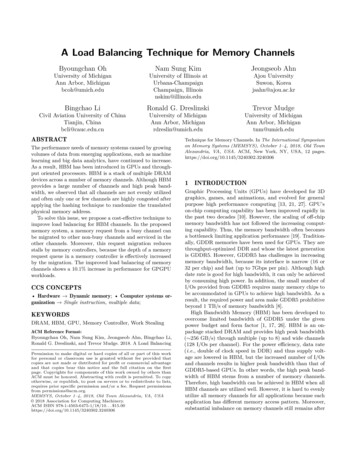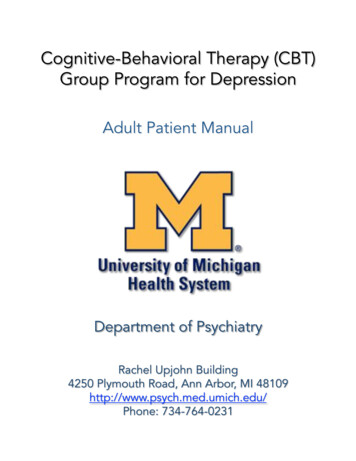
Transcription
AcknowledgementsWritten and Edited by:Kristen Miner, LMSWSara Tischler, LMSWDan DeSena, LMSW, DMAJessica Rimer, LMSW
AcknowledgementsParts of this manual were broadly adapted and integrated from the following sources aboutdepression, Cognitive-Behavioral Therapy, and group psychotherapy:Addis, M.E. & Martell, C.R. (2004). Overcoming depression one step at a time: The new behavioral activation treatment togetting your life back. Oakland, CA: New Harbinger.Beck, A.T., Rush, B.F. & Emery, G. (1979). Cognitive therapy of depression. New York: Guilford Press.Beck, J.S. (2011). Cognitive therapy: Basics and beyond, (2nd ed.). New York: Guilford Press.Burlingame, G.M., MacKenzie, K.R. & Strauss, B. (2004). Small-group treatment: Evidence for effectiveness and mechanismsof change. In M.J. Lambert, A.E. Bergin, & S.L. Garfield (Eds.), Bergin and Garfield’s handbook of psychotherapy andbehavior change (5th ed., pp. 647-696). New York: Wiley.Burlingame, G.M., Fuhriman, A., & Johnson, J.E. (2002). Cohesion in group psychotherapy. In J.C. Norcross (Ed.),Psychotherapy relationships that work: Therapist contributions and responsiveness to patients (pp. 71-87). New York: OxfordUniversity Press.Dimidjian, S., Hollon, S.D., Dobson, K.S., Schmaling, K.B., Kohlenberg, R.J., Addis, M.E., et al. (2006). Randomized trial ofbehavioral activation, cognitive therapy, and antidepressant medication in the acute treatment of adults with majordepression. Journal of Consulting and Clinical Psychology, 74(4), 658-670.Germer, C.K. & Neff, K.D. (2013). Self-compassion in clinical practice. Journal of Clinical Psychology: In Session, 69(8), 856–867.Hayes, S.C., Strosahl, K.D. & Wilson, K.G. (2012). Acceptance and commitment therapy: The process of mindful change.New York: The Guilford Press.Jacobson, N.S., Martell, C.R., & Dimidjian, S. (2001). Behavioral activation treatment for depression: Returning to contextualroots. Clinical Psychology: Science and Practice, 8(3), 255-270.Lejuez, C.W., Hopko, D.R., LePage, J., Hopko, S.D. & McNeil, D.W. (2001). A brief behavioral activation treatment fordepression. Cognitive and Behavioral Practice, 8, 164-175.Martell, C.R., Dimidjian, S. & Herman-Dunn (2010). Behavioral Activation for depression. New York: The Guilford Press.Martell, C.R., Addis, M.E. & Jacobsen, N.S. (2001). Depression in context: Strategies for guided action. New York: Norton.Mynors-Wallis, L. (2005). Problem-solving treatment for anxiety and depression: A practical guide. New York: Oxford.Neff, K. (2011). Self-compassion: The proven power of being kind to yourself. New York: Harper-Collins.Neff, K. D. & Germer, C. K. (2013). A pilot study and randomized controlled trial of the mindful self-compassion program.Journal of Clinical Psychology, 69(1), 28–44.Sochting, I. (2014). Cognitive-behavioral group therapy: Challenges and opportunities. Chichester, UK: Wiley Blackwell.Stoddard, J.A. & Afari, N. (2014). The big book of ACT metaphors. Oakland: New Harbinger.Williams, J.M.G., Teasdale, J.D., Segal, Z.V. & Kabat-Zinn, J. (2007). The mindful way through depression: Freeing yourselffrom chronic unhappiness. New York: Guilford Press.Zettle, R.D. (2007). ACT for depression. Oakland: New Harbinger.
PrefaceCBT Groups in the University of Michigan Department of PsychiatryiCognitive-Behavioral Therapy Basic Group for Depression Group Information iiCognitive-Behavioral Therapy (CBT) Cognitive Skills Group for Depression: Group Information iiiCognitive-Behavioral Therapy (CBT) Behavioral Activation Group for Depression:Group InformationivWhat is Cognitive-Behavioral Therapy?vCBT Is viWhat Does CBT for Depression Look Like? viiThe Path Through PsychotherapyviiiCBT Groups for Depression Rules of the RoadxChapter 1: Depression 1011.1Depression Is 1.2What causes depression?1.3The Depression “Downward Spiral”1.4My Depression “Downward Spiral”1.5When bad things happen 1.6When bad things happened to me 1.7The Internal Cycle1.8The Noble Three Pathways: Dealing with Negative EventsDepression Inconvenience Review Worksheet1.10NotesChapter 2: Self –care2.1“Self-care:” An important part of managing depressionSleep Hygiene2.3Exercise2.5Food for Your Mood?2.6My Self-Care Plan2.7NotesChapter 3: MindfulnessSlow down the mind Mindfulness and the BrainBeing More NonjudgmentalMindfulness ExercisesNotes3.13.23.43.53.6Chapter 4: Cognitive Therapy Skills4.1What are Cognitive Therapy Skills?Negative Automatic ThoughtsThoughts and Emotions4.7Identifying Negative Automatic ThoughtsThe Downward Arrow TechniqueDaily Thought Record WorksheetCognitive Distortions4.14Examples of Cognitive DistortionsThought Record “Plus”4.164.24.54.104.134.154.91.92.2
Examining the Evidence: “Restructuring” Negative Automatic Thoughts4.17Examining the Evidence: Questions to Develop Alternate Responses4.18Examining the Evidence: Written Methods4.20Examining Thoughts Worksheet4.21Examining the Evidence: A More Detailed Method 4.22Core Beliefs4.24Identifying Core Beliefs4.26Challenging Core Beliefs4.27Core Beliefs: Costs and Benefits4.28Core Belief Record: Recording Evidence That Contradicts My Old Belief4.29Core Belief Record: Recording Evidence That Confirms or Suggests My New Belief 4.30Life Goals Analysis4.31Life Goals Analysis Worksheet Example4.32Life Goals Analysis Worksheet (blank)4.33Self-Compassion4.34Common Thoughts About Depression and Its Treatment4.35Troubleshooting Cognitive Restructuring4.36NotesChapter 5: Behavioral Activation5.1What is Behavioral Activation?5.2The First Vicious Cycle5.5The Second Vicious Cycle5.6Your Cycles?5.7Activity Monitoring: Track Your Mood!5.8Activity Monitoring Worksheet5.9UP and DOWN activities5.10A Life Worth Living: Values, Pleasure, Mastery, and GoalsValues5.12Values Rating Sheet5.15Translating Values Into Activities5.16Pleasure5.18Mastery5.19Activities List: Pleasure and Mastery5.20Values, Pleasure, and Mastery Activities List 5.22Goal Setting5.23Activity Planning5.24Activity Planning Worksheet5.25Pleasure Predicting5.26Pleasure Predicting Sheet5.27Problem Solving and Acceptance5.28Dealing with Low Motivation 5.29Motivation Tips5.30Behavioral Activation Tips5.31Barriers and Resources Worksheet5.33Notes5.11Congratulations!Chapter 6: Appendix 6.1Cognitive-Behavioral Therapy Resources for Depression: Workbooks and Self-Help Books 6.2Cognitive-Behavioral Therapy Resources: Workbooks and Self-help Books by Problem Area 6.3Cognitive-Behavioral Therapy Resources: Other Resources 6.5Additional Worksheets6.6Notes
Depression ProgramCBT Basic Group forDepressionCBTBehavioralActivationGroup forDepressionCBTCognitiveSkills GroupforDepressionMindfulness-Based Cognitive Therapyfor depression relapse preventionAnxiety ProgramCBT Basic Group forAnxiety(2 sections)CBTCognitiveSkills Groupfor AnxietyCBTExposureGroup forAnxietyMindfulnessfor AnxietyGroupi.
What is this group all about? This group is an introduction to the basic concepts and skills ofCBT for depression. There are four sessions, each covering a different topic. These are offered weekly, the first four Tuesdays of every month. You can attend group sessions in any order that works for your schedule. If you cannot attend asession, you can make up the session the next time it is offered (typically in one month). Pleasemake every effort possible to attend all scheduled group sessions. Each session we will cover a certain set of CBT skills. It is possible any confusion you have aboutCBT or depression you have at the beginning of the group will clear up as you continue toattend the sessions. This group is not meant to fix your depression completely. We want to give you a chance to try out some of these techniques and better understand yourdepression. When you get done with this group you may want to continue with group orindividual CBT treatment here at U of M or be referred to a therapist in the community forcontinued work. If you have questions during the group, please ask! Your group facilitator will discuss with you which chapters to read for each group session. Askyour group leader if you have questions.Group Topics:Depression and CBT 101 (1st week of each month)Begin to understand your depression and what you can do about it using CBT skills.Self-Care and Mindfulness (2nd week of each month)We’ll discuss how exercise, diet, sleep and other habits impact our mood. You’ll also get anintroduction to “mindfulness” and how it can assist in depression recovery.Cognitive Restructuring (3rd week of each month)Understanding and challenging our “negative automatic thoughts” is one important element ofCBT treatment. We’ll learn the basics in this module.Behavioral Activation (4th week of each month)In this module you’ll learn how your behaviors impact the way that you feel. We’ll discusstechniques that can help you explore the behavioral patterns that contribute to mood changes.You’ll also learn how focusing on pleasure, goal setting, and values can improve your mood.ii.
What is this group all about? This group involves learning and practicing cognitive (thinking) skills. This isan active phase of treatment that will involve discussing your individualproblem, learning skills to address this problem, and practicingthem in-between sessions. Please see below for more information onthe content of the group. There are four weekly sessions, offered the first four weeks of every month. With practicebetween sessions, you may start to feel better within 4 weeks. Most patients will complete thegroup within 8, 12 or 16 sessions. Your individual course will vary depending on your specificsituation. Please make every effort possible to attend all scheduled group sessions. When you get done with this group you may want to continue with other groups or individualCBT treatment. Depending on how the group works for you, please discuss the course of yourtreatment with the clinician that referred you to this group. Success in this group depends on the work that is done in-between sessions. Discuss betweensession practice with your group facilitator.What you will learn and practice:“Psychoeducation” Understand negativeautomatic thoughts you mayhave about yourself, theworld, and the future. Understand “cognitivedistortions,” commonpatterns in thinking when weare depressed and anxious. Understand the connectionbetween thoughts andnegative emotions. Understand the differencebetween cognitive skills and“mindfulness” and when touse each.Awareness Practice Identify negative automaticthoughts and how they relate toemotions Identify and be aware of habitualpatterns in thinkingCognitiveRestructuring Practice “examiningthe evidence”behind thoughts tomodify them andreduce their negativeimpact on yourmood.Core Belief Work Understand the connectionbetween core beliefs andnegative automatic thoughts. Learn to understand and modifythe underlying beliefs andassumptions behind ourthoughts.Self-compassion Learn howpracticing treatingourselves kindly canimprove mood andlead to positiveemotions.iii.
What is this group all about? This group involves learning and practicing Behavioral Activation skills.This is an active phase of treatment that will involve discussing yourindividual problem, learning skills to address this problem, andpracticing them in-between sessions. Please see below for moreinformation on the content of the group. There are four weekly sessions, offered the first four weeks of every month. With practicebetween sessions, you may start to feel better within 4 weeks. Most patients will complete thegroup within 8, 12 or 16 sessions. Your individual course will vary depending on your specificsituation. Please make every effort possible to attend all scheduled group sessions. When you get done with this group you may want to continue with other groups or individualCBT treatment. Depending on how the group works for you, please discuss the course of yourtreatment with the clinician that referred you to this group. Success in this group depends on the work that is done in-between sessions. Discuss thereading or other between-session practice with your group facilitator.What you will learn and practice:Psychoeducation Understand howactivity and mood arerelated. Understand the“vicious cycles” ofdepression and howto reverse them.Activity Planningand PleasurePredicting Start incorporatingmore rewardingactivities into yourschedule and trackhow this impacts yourmood.Activity monitoring Become more awareof the connectionbetween your ownactivity and the upsand downs in yourmood.Addressing Barriersand Problem Solving Learn what to do whenpitfalls arise in yourbehavioral activationpractice. Sometimes the best wayto feel less depressed is tosolve problems; we’llexplore strategies here.Values, pleasure, and mastery Explore what makes life worth living for you:what you truly value, what brings you pleasure,and what you want to master or achieve in yourlife. Learn how to translate these core elements ofyour life into tangible goals and activities.Goal setting Learn how tobe SMARTabout settinggoals that canbe achieved,leading togreater rewardand positivemood.Addressinglow motivation Understand howmotivation works,how to staymotivated, andhow to addressmotivationproblems.iv.
Cognitive-Behavioral Therapy (CBT) is a short-term, evidence-basedtreatment for many problems, including depression. It is based onscience that shows that thoughts (cognitions) and behaviors (actions,choices) affect the way we feel (emotions).Emotions (feelings)Thoughts (cognitions)Behaviors (actions, choices)We want to be sure that our treatments are effective!Evidence-based means that there is scientific evidence to show thatsomething works.CBT is an evidence-based treatment that has been studied and shown to beeffective in hundreds of scientific experiments.While there is not a 100% guarantee that CBT will work for you, it is likelythat with practice and hard work you will receive benefit from thesetechniques.How to use this manualThis manual includes a great deal of information on depression and CBT. You will get the most out of ourgroup program if you take notes during the group and then review the manual between sessions. Some ofthe skills may be very pertinent to you, and others less so; regardless, we hope that you will give CBT agood try (including consistent practice in between sessions for 4-6 weeks) before determining if it is agood fit for you.v.
Cognitive-Behavioral Therapy is an effective, evidence-based treatment that has been proven tohave an impact on depression in both the short- and long-term. Our department specializes indelivery of this intervention to people like you, who want depression to stop interfering with theirlives. Below we explain some of what to expect from CBT treatment.Cognitive-Behavioral Therapy is regular. It works best when you come to treatment once per week for most of the treatmentcourse. It is common to change course to once-every-other-week or once-a-month when thesymptoms have been reduced and you have entered the “maintenance” period of treatment. typically lasts for between 12 and 16 sessions. Depending on the problem, it may take more orless. This is not a treatment that is meant to last for significant amounts of time. is structured. This is not the style of therapy in which one comes into the session only to “vent”or have someone with whom to talk. The treatment is focused specifically on treatment aims,which usually include reducing the impact of depression on our lives and feeling better, bylearning skills and techniques to respond to depression when it arises. has a variety of skills. As you will see as you dig in to this manual, there are different anglesfrom which to address your depression. Most people find it helpful to use a variety of skills,instead of searching for just one “silver bullet.” There is most likely not just one answer to yourdepression. However, depression can usually be managed well if one practices multiple skillsrepetitively over time and incorporates them into the flow of daily life. requires practice. Call it homework, daily practice, or whatever you choose. Regardless, it takesdaily repetition to learn skills and retrain our depression-influenced habits. A rule of thumb is toexpect to spend about one hour a day practicing CBT in-between sessions. We want you to feelbetter outside of sessions and maintain this after you finish treatment, not just while you are atour clinic. depends on follow-through. The most important factor in whether or not treatment works isthe amount of work you put into it. Consider it an investment in a future with more freedom,enjoyment, and flexibility. is collaborative. Individual and group CBT are structured, but are also centered around yourlife aims. The patient and therapist work together to define treatment targets, adapt skills to thepatient’s unique circumstances, and troubleshoot as barriers arise. If certain skills do not work, itis common to try others. If something does not seem to be working, one can discuss this with thetherapist or group leader. Communication is an important part of CBT. is evidence-based. This means that the concepts and skills are based on scientifically-validatedconcepts, and the interventions have been tested to be sure they are helpful.vi.
How we think and act can greatly influence howwe feel. The better we understand (andchallenge) thoughts and behaviors that areinfluenced by and contribute to depression, themore skillful and in control we feel. We learn tomove away from being on “automatic pilot” andletting our depression make choices for us.Below are the various components of CBT and how they aredesigned to treat the depression.What we’ll learn: About depression(“psychoeducation”)-What people experience-What causes it Self-care (sleep, diet, exercise,etc.)What they target: Social isolation Decreased physical activity Avoidance Motivation problems Mindfulness Negative thinking “Cognitive” (thought)restructuring Hopelessness Behavioral Activation:-Values, pleasure andmastery-Activity monitoring andscheduling-Pleasure predicting-Goal setting-Motivational strategies-Managing barriers toactivation Difficulties enjoying things Poor self-esteem Worried thoughts Sleep problems Problems with appetite and eating Fatiguevii.
There is a great deal of scientific research onpsychotherapy, and we know a lot aboutwhat can be helpful for people. We continueto learn more and more about how to usepsychotherapy to help as many people aspossible.However, because everyone is different, andour brains and lives are very complex, rightnow it is often hard to know exactly what it isthat will help a particular person feel better.On the next page, follow thepath from the bottom of thepage upward for some tipsto make your “path throughpsychotherapy” morehelpful and rewarding.viii.
See this as just one piece of the puzzle in your process of better understandingyourself and moving toward what you want in your life. Get all you can out of it andthen make efforts to find out what other types of work could be helpful. Forexample, maybe you did a great deal of work on managing your depression withcognitive and behavioral skills. Now you believe that you want to improve yourrelationships to achieve more in that area of your life.Manage barriers to showing up regularly to treatment and practicing skills: improvementdepends primarily on follow-through and the amount of work you put into your therapy.Address depression from different angles. There is no one “silver bullet” that willchange depression all by itself. Usually a combination treatment, or mixed approachis what works best to make depression better. This also means putting in some effortto understand the different ways to manage your depression.Practice skills over, and over, and over. It usually takes time for changes in ourbehavior and thinking to lead to feeling better. Like learning an instrument, we arepracticing new ways of doing things that will feel “clunky” at first, and becomemore comfortable over time.Take small steps toward change each day. Try not to wait for “light bulb moments,”“epiphanies,” or for something to take it all away instantly.Expect ups and downs during the process. Think of it as “2 stepsforward, 1 step back.” Try not to get too discouraged or give upwhen things seem to move backward or stagnate.Make it about you: engage in your treatment because you want to improve your life, takeresponsibility for achieving you aims, and feeling better, not because others are telling youto do so. Remember that even if you are being pushed to engage in therapy by someoneelse, that relationship must be important enough for you to consider this option!Maintain an open mind about the possibility of change, while being realistic abouthow fast this change can happen.Especially at first, gauge success according to how you change your responses to stress,uncomfortable emotions, and body sensations, not whether or not these things exist orcontinue to occur. Focus on valued action, even more than just “feeling better.”“Credibility:” Make sure the treatment in which you are engaging makes sense toyou and seems to be addressing your problem. There are different paths to thesame goal. If this type of therapy is not working for you, you are confused aboutwhat you are doing, or you have any other concerns, talk to your clinician rightaway. Clinicians are trained to have these discussions with their patients!Make sure your definition of the “problem” is the same as the clinicians with whomyou are working. Maybe they think it is “depression” and you think it is somethingelse. Try to clarify this with your clinicians.ix.
Please be respectful to other group members. Try to notinterrupt others or offer advice. Please direct personal issues to your individual provider. Confidentiality: Please keep the information shared in ourgroup private. If you need to speak with your group leader in betweensessions, please call (734) 764-0231. You may call if you arehaving problems with your homework or want to discuss anyissues related to group or your course in therapy. If you have a psychiatric emergency, contact PsychiatricEmergency Services at 734-936-5900 (24/7). We want to help you figure out the next steps of yourtreatment, so please be proactive in asking questions orcontacting us if you are confused about the course of yourtreatment.x.
In this chapter we’ll learn .what depression is and what we think causes it how the depression “Downward Spiral” works and how it canmake depression worse how negative life events and depression can be related how our own relationship with our emotions can makedepression worse three main ways to deal with negative events how depression may be impacting your life andhow to start becoming more motivated to treat it the components of CBT that are used to treatdepression1.1
how you act: Tendency to isolate socially how your body reacts: Decreased physical activity Difficulty falling or stayingasleep Not engaging in things that wereonce fun/enjoyable or interesting. Poor or excessive appetite Argumentative Fatigue Avoidant/overly protective how you feel: how you think: Hopelessness Persistent negativethoughts aboutyourself, the world, oryour future Low “self-esteem” Pessimism Suicidal thinking Worried thoughts Sad Guilt/shame Low motivation Numb or that“nothing matters” Anxious/worried Irritable Lack of ability toenjoy things(“anhedonia”)Everyone feels blue or sad sometimes. In fact, it’s normal to have a bad day every once in a while,shed tears after a sad movie, or feel nervous before a big day and lose sleep. These are commonhuman experiences that are a healthy and normal part of life.However, when the elements listed above last for days, weeks, or longer, we may be sufferingfrom an episode of Major Depressive Disorder, also called “depression.” A person is typicallydiagnosed with depression when they experience periods of two weeks or more at a time wherethey feel low mood, lack of enjoyment or pleasure, poor self-esteem (feelings of worthlessnessand/or guilt), changes in sleep and appetite, and social isolation.1.2
Do I have a “chemical imbalance?”Doctors and psychologists (as well as therapists, philosophers, and theologians, among others)have been making efforts to understand the underlying causes of depression since ancient times.Since the middle of the 20th century, we have made many important advances in understandingdepression, one of which was the discovery that certain important brain chemicals are “out ofbalance” for those people that are depressed. This led to one very important advance indepression treatment, the advent of antidepressant medications such as Prozac. It was commonfor patients in the 1980’s to be told that they had a “chemical imbalance” that was causing theirdepression.While this is true to some extent, since then we have learned through further research that the“cause” of depression is more complicated, involving many elements, influenced by both“nature” and “nurture.” Some of those factors are listed below.NatureGenetics: Inherited vulnerability tophysical and/or mental illness.Chemical imbalance: Imbalance ofimportant brain chemicals called“neurotransmitters.”Hormones: Imbalances due topuberty, pregnancy/postpartum,menopause, adrenal, thyroid, andpituitary disorders.andNurtureEarly life experiences: Patterns ofattachment with parents, early lifestress, and trauma.Modeling from important elders/authorityfigures:Learnedbehaviors from others in your lifethat might have been depressedor anxious. Learned thoughtsabout the world and self.Major life changes: Moving a lotgrowing up, stressful jobs, changein health status, divorce, and lossof family members or significantpeople.1.3
Regardless of the “cause” of depression for you (see the previous section: “What causesdepression?”), once it starts, it often causes a “downward spiral” that leads to increasingly badfeelings and further negative events.For example, isolating socially may cause others to stop reaching out to us and relationships maydissolve. Or, our poor view of ourselves may come across to others as low confidence and peoplemay stop respecting us or treat us poorly.Stressors/traumaticevents/life challengesLong-term stressorsin relationshipsDepressive feelings(low motivation, fatigue,overwhelming sadnessor guilt, etc.Negative thoughtsabout ourselves,others, or the worldFurther negative experiences(people stop contacting us, weare treated poorly, etc.)Avoidant, passive, orisolative behaviorsDeeper and deeperdepression and“giving up”This cycle may take many forms. Use the next page to betterunderstand your own depression “downward spiral.”1.4
List some of the factors in each category below and think about how one factor mayinfluence the others.Stressors/traumatic events/life challengesLong-term stressors inrelationshipsNegative thoughts aboutourselves, others, or the worldDepressive feelings(low motivation, fatigue, overwhelming sadness or guilt, etc.Further negative experiences(people stop contacting us, weare treated poorly, etc.)Avoidant, passive, or isolativebehaviorsDeeper and deeper depression and “giving up?”1.5
There are many causes of depression. One has to do with the ways that difficult life circumstances can lead naturallyto feelings of hopelessness. In some situations we may be stuck—it is authentically bad, we don’t have much helpfrom others, we can’t change the painful situation, and it is difficult to accept the situation as it is.The combination of stressful life events (especially being neglected or harmed by caregivers and other importantpeople)—lack of social support, and inability to influence a situation to change it— leads to an understandable“giving up.” After all, why continue to try to do something if it isn’t working? Our bodies have a protective device thathelps us “shut down” and conserve energy when our efforts are continually met with failure. This is especiallyimportant in early life relationships where it is necessary for our survival to be protected and loved by caregivers.Then Stressful events(for example: beingcriticized byimportant personsover and over)Little to no helpfrom others to solveproblem or getsupport around thestressorEffort to fixproblem on ownwith no effectIf this happens over and over, this pattern becomes “wellpracticed,” making it more likely to happen automatically in thefuture.“Shutting down”response (body goesinto a state of lowenergy usage/efficiency)When current experiences remind us ofthose earlier ones, ourbodies go right to allthe old patterns andfeelings automatically,until we can change ourown responses to these“triggers” over time.Current event(that reminds usof past event)Necessary and adaptive, yetharmful coping behaviors(repetitive behaviors, selfharm, avoidance, etc.)Strong emotionsthat cannot behandled on ownSelf-critical thoughts aboutour inability to be competent in this “lose-lose”situationNow Strong emotions that are similar to those originally experiencedAutomatic reliance on repetitive behaviors that worked for usbefore; effort to fix problem or emotions this way, with orwithout successThoughts about our our incompetence (related to originalthoughts of being able to be competent in the earlier “loselose” situation.“Shutting down” response (body goes into a state of lowenergy usage/efficiency)
Use the model from the previous page to understand how events may have shaped your thoughts,emotions, and behaviors.Then Stressful events(for example: beingcriticized by importantpersons over and over)Social support?Strong emotions?“Shutting down” response?Self-critical thoughts?Coping behaviors?Current event(that reminds usof past event)Effort to fix problem (When did itwork? When did it not work?)Now Strong emotions that are similar to those originally experienced?Automatic behaviors and efforts to fix situation or emotion?Self-critical thoughts?“Shutting down” r
Cognitive-Behavioral Therapy Resources: Workbooks and Self-help Books by Problem Area 6.3 Cognitive-Behavioral Therapy Resources: Other Resources 6.5 Additional Worksheets 6.6 Notes . Anxiety Program Depression Program CBT Exposure Group for Anxiety CBT C

